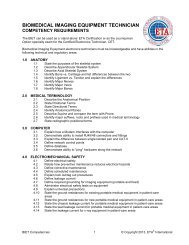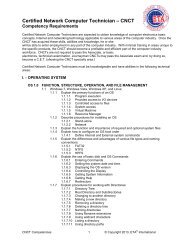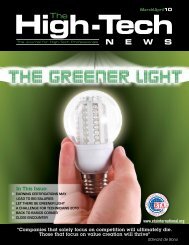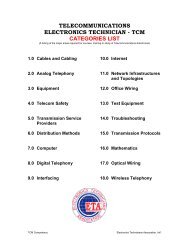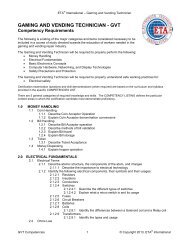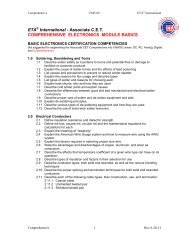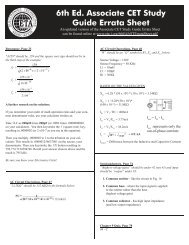fiber optics technician â outside plant (fot-osp) - ETA International
fiber optics technician â outside plant (fot-osp) - ETA International
fiber optics technician â outside plant (fot-osp) - ETA International
Create successful ePaper yourself
Turn your PDF publications into a flip-book with our unique Google optimized e-Paper software.
Fiber Optics Technician – Outside Plant Knowledge Competencies4.0 SINGLE-MODE FIBERS IN WAN, MAN, FTTx AND PREMISES NETWORKS4.1 List the types of single-mode <strong>fiber</strong> used in premises applications4.2 Describe acceptable methods of terminating single-mode <strong>fiber</strong>4.3 List the types of <strong>fiber</strong> used in metropolitan area networks (MANs)4.4 Describe the type of <strong>fiber</strong> used for Wavelength Division Multiplexing4.4.1 Dense Wavelength Division Multiplexing (DWDM)4.4.2 Coarse Wavelength Division Multiplexing (CWDM)4.5 List the <strong>International</strong> Telecommunication Union (ITU) specification for the two common singlemode<strong>fiber</strong> types4.6 Compare different techniques used in <strong>fiber</strong> manufacturing4.7 List different types of <strong>fiber</strong> optic cable tolerances4.8 List the <strong>fiber</strong> type specified in the ITU standard for FTTH4.9 Describe the different types of dispersion in single-mode applications5.0 FIBER OPTIC CABLES5.1 In a cross-section drawing of a stranded <strong>fiber</strong> optic cable, explain the purposes of each segment5.2 Identify the segments in the drawing of a cross section of a central tube <strong>fiber</strong> optic cable5.3 Explain why and where loose tube cable is used5.4 Compare tight-buffered cable with other types of <strong>fiber</strong> cable5.5 Explain the differences between the strength member in both stranded and central tube <strong>fiber</strong> opticcables5.6 Name the cable jacket material used in common types of <strong>outside</strong> <strong>plant</strong> cables5.7 Explain the purpose of installation specifications5.8 Define an indoor distribution cable structure and compare it with loose tube and central tube <strong>fiber</strong>optic cables5.9 List reasons for utilizing armored <strong>fiber</strong> cables5.10 Describe the purpose of cable ribbons and how they are used in <strong>fiber</strong> optic cables5.11 Explain the purpose and indicate where the TIA/EIA-598 color code is used5.12 Describe manufacturer markings on cable jackets and how they are used5.13 Explain the use of sequential cable markings5.14 Describe the two types of outdoor style cable structures5.15 Compare indoor and outdoor cables, their applications and benefits5.16 Describe the use of cable gels, powders and tapes5.17 Define tensile strength of a <strong>fiber</strong> cable5.18 Describe the dynamic load of a <strong>fiber</strong> cable5.19 Define ‘static load’ as it refers to <strong>fiber</strong> cabling5.20 Describe the detrimental effects of exceeding the minimum dynamic bend radius of a <strong>fiber</strong> cable5.21 Compare static versus dynamic bend radius in <strong>fiber</strong> optic cabling5.22 Describe the differences between <strong>fiber</strong> optic trunk, distribution and drop cables used in FTTxinstallations5.23 Explain the importance of the attenuation specification in <strong>fiber</strong> optic cables and how it is used5.24 Define microducts and microduct cables6.0 ACTIVE DEVICES6.1 Name the types of active optical devices used in <strong>fiber</strong> <strong>optics</strong>6.2 Explain the purposes and differences in the safety classifications for light sources used in <strong>fiber</strong>communications6.3 Name the type of light source used in OSP (Outside Plant) applications6.4 List the common wavelengths used in single-mode <strong>fiber</strong> communications systems and theadvantages and disadvantages of each6.5 Explain how to measure the output power of a light source6.6 Explain dBm and its role in testing transmit and receive optical power levels6.7 Explain the impact of Fresnel reflections on laser transmission6.8 Explain the impact of proper optical <strong>fiber</strong> cleaning materials and their effect on transmission quality6.9 Describe the basic role of the photodiode in <strong>fiber</strong> optic communications6.10 Describe the function and relationship of optical attenuators to detectorsFOT-OSP Competencies 2 © Copyright 2014, <strong>ETA</strong> ® <strong>International</strong>



